Is Smoke from Wildfires Affecting Crop Yields?
Written by Mark Jeschke, Ph.D., Agronomy Manager
8/23/2021
Written by Mark Jeschke, Ph.D., Agronomy Manager
8/23/2021
The past several years have been marked by an increase in the frequency and severity of wildfires in the western U.S. and Canada. The effects of these fires have been devastating on the areas directly impacted, and smoke from the fires has been a frequent health concern in nearby population centers. It has also become increasingly apparent that the impact of these wildfires can extend far beyond the immediate area. Wildfire smoke can and does impact air quality throughout the entire continental U.S.
In the Corn Belt region, noticeable levels of smoke in the air during summer and fall have now become commonplace. Wildfire smoke is often most noticeable in the evenings, with hazy red sunsets resulting from the filtering of sunlight through the particulate matter suspended in the atmosphere. During the day, the smoke creates a persistent cloudy haze in the air, reducing the intensity of direct sunlight and making it more diffuse.
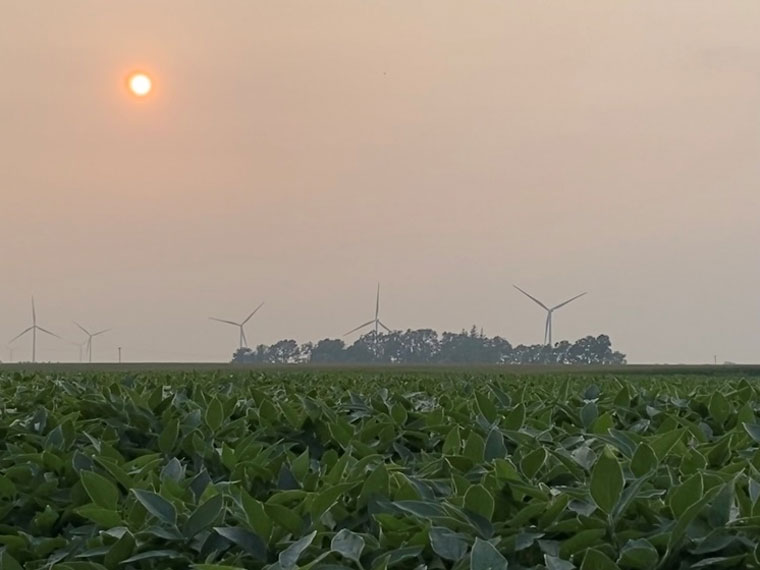
Smoky sunset in central Iowa. July 31, 2021.
The increased frequency of smoky days in agricultural areas raises the question of what impact the smoke might be having on crop productivity. Ample sunlight is critical for maximizing plant photosynthesis and crop yield, and lower than normal solar radiation during grain fill can be detrimental. Corn, in particular, is susceptible to reduced yields and reduced standability if the plants need to remobilize carbohydrates from the stalk to make up for a deficit in photosynthesis. This weakens the stalks and opens the door for stalk rot pathogens.
Wildfires in western North America have gotten considerably worse in recent years. Over the past forty years, the total burned area from wildfires in the U.S. has approximately quadrupled, from around 2 million acres annually to over 8 million acres (Figure 1).
The increase in fire risk has been driven by two major factors: increased fuel load in forested areas resulting from decades of fire management practices focused on fire suppression, and increased fuel aridity due to a hotter and drier climate.
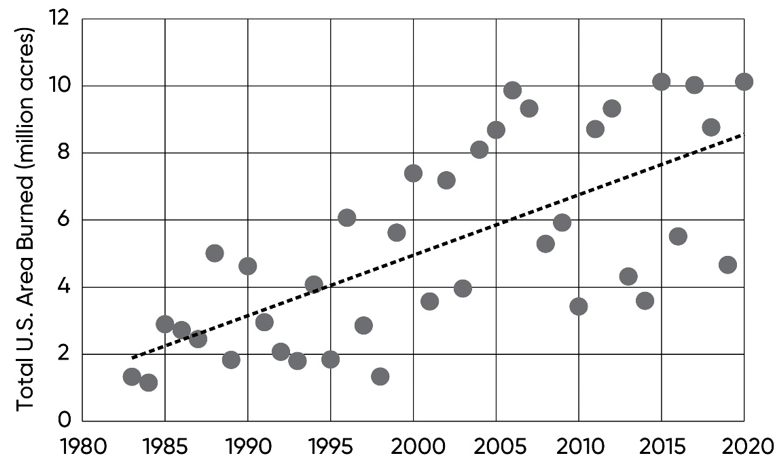
Figure 1. Total acres burned by wildland fires in the U.S., 1983-2020. Source: NIFC Wildland Fire Statistics, 2021.
Forest Management
Fire is a natural feature of many forest ecosystems in western North America and controlled burns were common practice across the landscape for generations. In the early 20th Century though, focus started to shift away from forest management in favor of fire suppression after a devastating fire in 1910 known as the “Big Burn” consumed over 3 million acres across Washington, Idaho, and Montana and killed at least 85 people. This event had a long-term impact on the policy direction of the U.S. Forest Service, which had been founded five years prior (Tidwell, 2010).
The outcome of decades of policy focused on fire suppression has been a buildup of fuel in many forested areas. Even though the importance of prescribed burning for fire risk mitigation is now well-understood, doing it has become more difficult due to the expansion of residential development in the wildland urban interface and the diversion of limited fire management resources into protecting homes and businesses from increasingly frequent and intense wildfires. A massive increase in tree mortality following an extended period of drought in California has further increased the supply of combustible fuel (Stephens et al., 2018), dramatically increasing the near-term risk of devastating fires in affected areas.
Climate Change
The risk posed by increased fuel loads in western forests has been exacerbated by climate change, which has manifested though increased temperatures and lower precipitation during the fire season, a lengthening of the fire season due to higher spring and fall temperatures, earlier snowmelt, and reduced river flows. All of these factors have contributed to make fuel loads in forests drier and more combustible (Overpeck and Udall, 2020).
The increase in fire activity over the past 20 years has largely been driven by climate change, with hotter, drier conditions leading to larger and more frequent fires (Abatzoglou and Kolden 2013). The six worst wildfire years in California – years in which over 1 million acres burned – have all been years with above-average temperature and below-average precipitation during the July to November fire season (Figure 2). This set of conditions is occurring with increasing frequency. Average fire season temperatures have exceeded the 20th Century average every year since 2004, with the 2020 season setting a new high of over 4 °F above average as well as a new record of over 3 million acres burned.
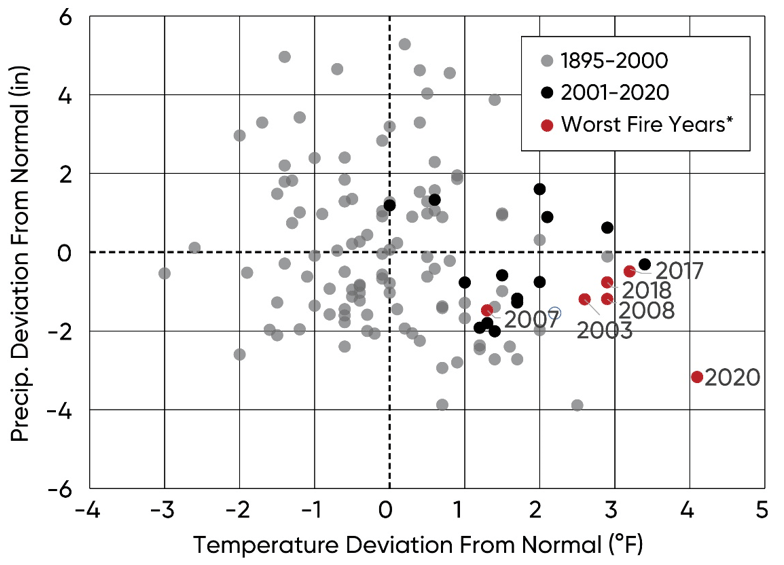
Figure 2. California temperature and precipitation deviation from average from July-November of each year, 1895-2020.
* Over 1 million acres burned.
Source: NOAA National Centers for Environmental Information.
Impact of Wildfire Smoke
The increase in wildfire activity has led to a substantial increase in the number of days each year impacted by smoke in the air. Effects of wildfire smoke extend far beyond the west coast, with increases observed throughout the U.S. (Burke et al., 2021). The heat generated by active fires lifts smoke high into the atmosphere. At high altitudes, the smoke can travel with jet stream winds across the continent (NASA, 2017). Pockets of concentrated smoke can sometimes occur far from the fires that generated it (Figure 3). Smoke is most noticeable and poses the greatest human health threat when it descends to the surface; however, smoke at any altitude has the potential to affect crop growth by reflecting and scattering incoming sunlight.
Given what is known about the factors that have led to increased wildfire activity, it’s a virtual certainty that wildfire smoke in the atmosphere will continue to increase in frequency and concentration for the foreseeable future, making it important to understand how crop growth and productivity might be affected.
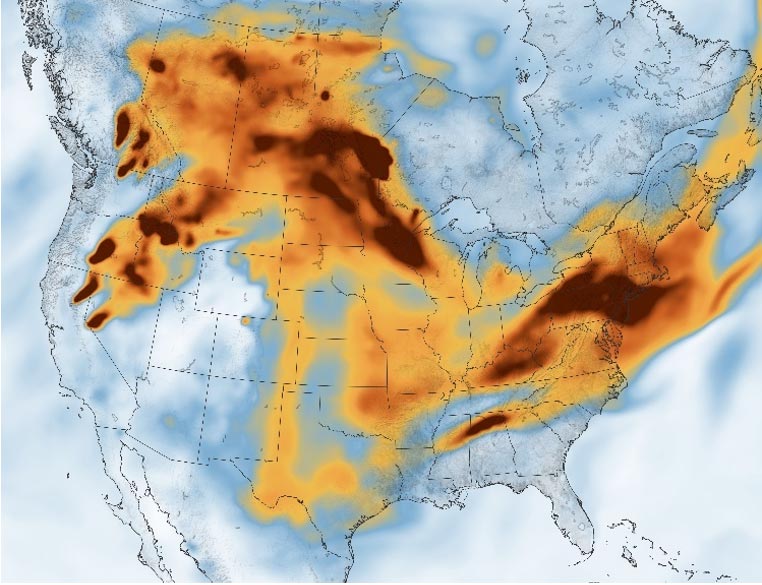
Figure 3. Smoke concentration in the atmosphere over North America, July 21, 2021. Source: NASA Earth Observatory.
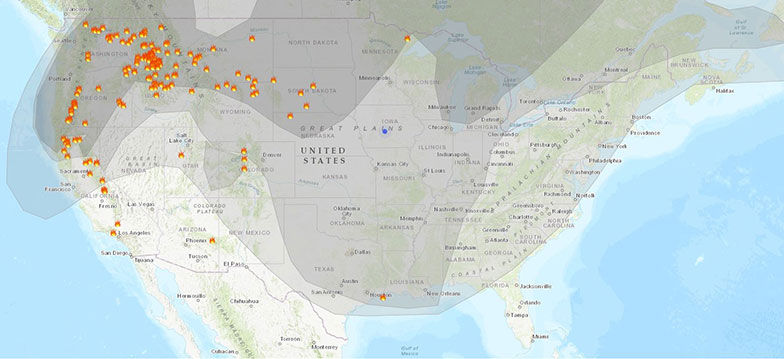
Figure 4. Map showing active wildfires and areas impacted by smoke across the U.S. on August 6, 2021. Real-time maps and air quality indicators are available at https://www.airnow.gov. (Click here or on the image above for a larger view.)
The impact of wildfire smoke on crop growth is complex and involves competing effects that can both enhance and suppress photosynthesis. Among the many potential effects on crop growth are three primary factors with the capability to directly impact photosynthesis: reduced sunlight intensity, increased sunlight diffusion, and increased ozone (O3) levels.
Problem: Reduced Sunlight Intensity
The most obvious effect of wildfire smoke in the atmosphere is a reduction in total solar radiation. Much like a hazy cloud cover, smoke reflects a portion of incoming sunlight, reducing the amount of light available to plants. Since plants depend on sunlight to carry out photosynthesis, any reduction in light is potentially detrimental to crop productivity. Plants with the C4 carbon fixation pathway, such as corn, have a higher light saturation point, making them more susceptible to reductions in solar radiation than C3 plants such as soybeans.
Potential Benefit: Increased Diffusion of Sunlight
In addition to reflecting a portion of incoming light, smoke also scatters it, making the light available to plants more diffuse. Wildfire smoke can significantly increase the diffuse fraction of photosynthetically active radiation (PAR), which can actually benefit plants by increasing their light use efficiency. The potential effect of more diffuse light on plant growth depends on the characteristics of the plant canopy, with taller, higher leaf area index, and multilayer canopies likely to benefit more from diffuse radiation than shorter plants.
Problem: Increased Ozone Levels
Ozone (O3) is most commonly known for the naturally occurring ozone layer in the upper atmosphere that shields Earth from harmful ultraviolet radiation. Ground-level ozone, however, is a damaging air pollutant that is harmful both to human health and plant growth. Ozone is formed when pollutants, mainly nitrogen oxides and volatile organic compounds, react in the atmosphere in the presence of sunlight. Wildfires emit large quantities of these precursor compounds. Nitrogen oxides and organic carbons produced by wildfires can be transported long distances by regional weather patterns before they react to create ozone in the atmosphere, where it can persist for several weeks.
Ground-level ozone is very harmful to plants, causing more damage to plants than all other air pollutants combined (USDA ARS, 2016). Ozone is a strong oxidant and damages plants by entering stomata and oxidizing (burning) plant tissue during respiration. Elevated ozone levels have the potential to significantly reduce crop yields. Dicot species such as soybean are generally thought to be more susceptible to yield reduction than monocot species such as corn (Heagle, 1989), although research has shown that corn and soybean are both susceptible to yield loss from ozone pollution (McGrath et al., 2015).
Complex and Interacting Effects
Of the three primary effects of wildfire smoke on crop growth, two of them – reduced total solar radiation and elevated ozone – are clearly negative, while increased diffusion of solar radiation could potentially be positive for crop growth. The ultimate effect on crop growth and yield will depend on the relative impact of each of these factors. For example, any benefit derived from increased diffuse radiation could be negated if the reduction in total solar radiation is too great. Interaction between effects is possible as well. For example, reduced solar radiation from smoke could suppress the formation of ozone from precursor compounds, a process that is dependent on sunlight. Additional effects could come into play as well. Reduction in solar radiation can reduce surface temperatures, which may be good, bad, or neutral depending on the timing and circumstances.
Numerous experiments over the years have studied the impact of reduced solar radiation on corn yields using shade cloths that cover a portion of the crop canopy and reduce the intensity of incident solar radiation by a certain amount. These studies have provided some important insights on the effects of reduced solar radiation on corn.
Reductions in yield can be dramatic. Studies that have included shade treatments that reduce light by 50% or more during grain fill have seen corn yield drop by more than half (Table 1) (Yang et al., 2019).
Table 1. Percent corn yield reduction associated with three different levels of shading (15%, 30%, and 50%) for two hybrids at three different plant densities (Yang et al., 2019).
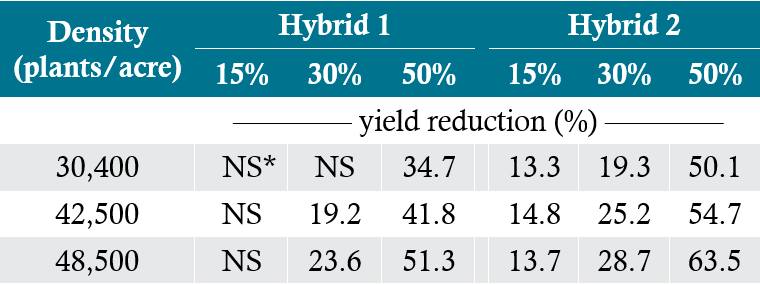
Timing and intensity matter. Studies that have included multiple degrees of shading have found, not surprisingly, that the more solar radiation is reduced, the greater the effect on yield. Yang et al. (2019) found that impact on yield more than doubled when shading was increased from 30% to 50% (Table 1). The timing of shading is also of critical importance in corn. Reductions in solar radiation during silking and grain fill have a much greater impact than the same level of reduction prior to silking (Table 2) (Liu and Tollenaar, 2009; Reed et al., 1988).
Table 2. Effect of shade treatment timing on corn yield (Liu and Tollenaar, 2009.)

¹ Weeks relative to silking: a -5 to -1, b -1 to +2, c +2 to +5. Shading treatments reduced solar radiation by 55%
NS = not significant, ** = highly significant, (α=0.05)
Effects can vary by hybrid and plant density. Yang et al. (2019) compared effects of shading during grain fill on two different hybrids at three different plant densities. When solar radiation was only reduced by 15%, yield impacts were similar across plant densities. As the degree of shading was increased, however; yield reductions were greater at higher plant densities. The two hybrids compared in the study also differed in their response to reduced light levels, with one hybrid consistently affected more than the other. At the 15% level of shading, yield of the more sensitive hybrid was reduced by 13-15% while the more tolerant hybrid did not have a significant reduction in yield (Table 1).
Reduced solar radiation can also affect stalk quality. In addition to direct effects on corn yield, reduced solar radiation can reduce harvestable yield by negatively affecting stalk quality and standability. Upon successful pollination, ear development places a great demand on the plant for carbohydrates. When the demands of the developing kernels exceed the supply produced by the leaves, stalk and root storage reserves are utilized. Environmental stresses which decrease the amount of photosynthate produced by the plant can force plants to extract even greater percentages of stalk carbohydrates, which preserves grain fill rates at the expense of stalk quality. As carbohydrates stored in the roots and stalk are mobilized to the ear, these structures begin to decline and soon lose their resistance to soil-borne pathogens. Instances of severe stalk rots and lodging have often been observed in association with prolonged periods of low solar radiation during grain fill (Figure 5 and Figure 6).
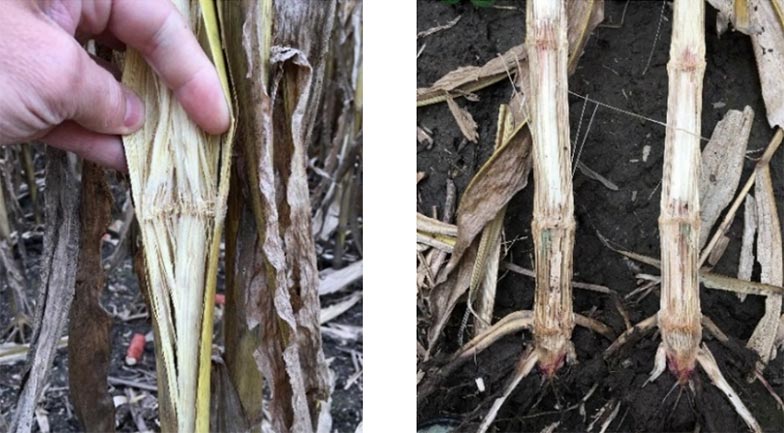
Figure 5. A Pioneer hybrid plot in 2018 in which poor stalk quality was associated with below average solar radiation throughout the grain fill period. (September 28, 2018; Stephenson County, IL)

Figure 6. Daily and cumulative solar radiation for the Pioneer hybrid plot shown in Figure 5. Cumulative solar radiation fell below average by mid-June and continued to decline throughout the entire grain fill period. (Click here or on the image above for a larger view.)
How Much Does Wildfire Smoke Reduce Solar Radiation?
Shading studies in corn have often involved treatments that reduced solar radiation by large percentages, similar to reductions that would be caused by moderate to heavy cloud cover. Data collected in Johnston, IA, found that solar radiation reductions from cloud cover ranged from 23 to 62% (Figure 7). So how much does wildfire smoke reduce solar radiation?
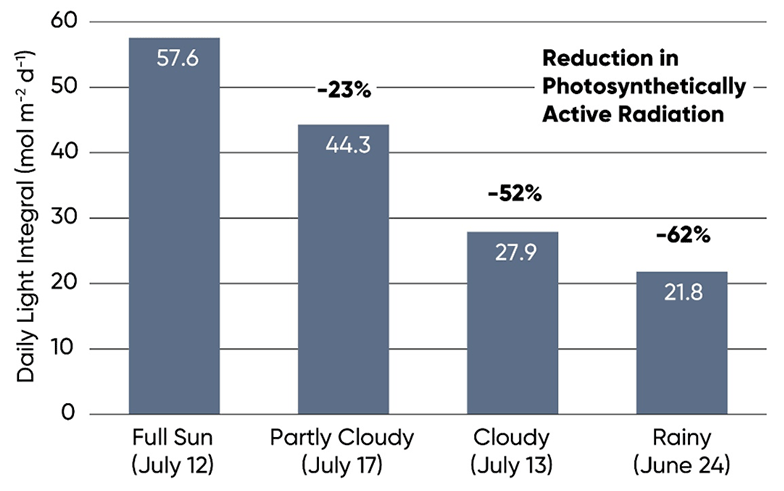
Figure 7. Daily PAR received in Johnston, IA under sunny, cloudy, and rainy conditions on four different days during summer of 2015.
A study conducted in 2018 in the California Central Valley found that total PAR was only reduced by 3.6% on average due to wildfire smoke, while the diffuse fraction increased by over 34% during the study period from mid-July to the end of August (Hemes et al., 2020). The predicted effect on corn was a 2.5% increase in photosynthesis, as the positive effect of more diffuse PAR exceeded the negative effect of reduced total PAR. However, under the smokiest conditions observed during the study period, photosynthesis was predicted to decline by over 8%. The authors of the study noted that it focused on ecosystem productivity, not crop yield, and that yield may not respond to increased diffuse PAR in the same way.
Another study in California focused on lake ecosystems found that wildfire smoke over a 55-day period in 2018 reduced PAR by 11% compared to the 2014-2017 average (Scordo et al., 2021). Ohio State University researchers compared photosynthetic photon flux density in June and July of 2021, a period marked by frequent smoke in the atmosphere, with the average of the previous 4 years and found that levels were reduced by 6-7% (Table 3).
Table 3. Daily average photosynthetic photon flux density in Wood County, Ohio (Lindsey et al., 2021).
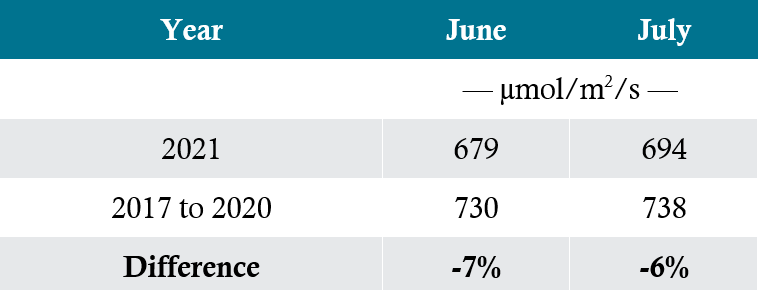
Determining the actual impact of wildfire smoke on crop yields is extremely difficult for a number of reasons, including the multiple, competing effects involved and the difficulty in isolating the effects of smoke from other influences. Conducting controlled experiments on wildfire smoke is impractical, so research has often focused on measuring the effects of smoke events as they occur. Experiments such as shading studies can provide important insights into the possible impact of specific aspects of smoke cover on crop yield but cannot replicate the full suite of effects.
Based on what is known about the effects of reduced solar radiation and elevated ozone on crops, it seems very plausible that wildfire smoke could cause reductions in crop yields. The scope of possible outcomes likely ranges from slightly beneficial to significantly harmful. The study by Hemes et al. (2020) probably represents something close to a best-case scenario where the benefit of increased diffuse PAR exceeded the negative effects of slightly lower total PAR and elevated ozone. The heavier the smoke, the more likely reduction in total PAR will be the dominant factor.
In general, corn is likely to be more susceptible to the effects of wildfire smoke than soybeans. Corn has a higher light saturation point due to its C4 photosynthetic pathway, so is more likely to be impacted by reductions in total PAR. Corn may also experience reduced standability if lower solar radiation during grain fill forces plants to remobilize more carbohydrates from the stalk. The risk of yield loss and reduced stalk health is likely greater when smoke imposes an additional stress upon a crop that is already experiencing the effect other stresses, like disease or drought stress. Clearly identifying all contributing stresses can be very difficult, much less being able to precisely quantify the impact each of the those compounding factors may have had on the crop.
Corn and soybean can both be harmed by elevated ozone levels; however, both the production of ozone from wildfire smoke and the intake of ozone through plant stomata can be influenced by a number of different factors. Corn and soybean already experience wide scale reductions in yield from ozone associated with other sources of air pollution (McGrath et al., 2015), so the additional effect of ozone specifically associated with wildfire smoke could be difficult to determine.
Wildfire smoke is not a problem that’s going away anytime soon. Based on what we know about the contributing factors, wildfires in western North America are likely to increase in frequency and intensity in the coming years. The effects on wildfire smoke on both agricultural and natural ecosystems will likely continue to be an active area of research.
The foregoing is provided for informational use only. Please contact your Pioneer sales professional for information and suggestions specific to your operation. Product performance is variable and depends on many factors such as moisture and heat stress, soil type, management practices and environmental stress as well as disease and pest pressures. Individual results may vary. Pioneer® brand products are subject to the terms and conditions of purchase which are part of the labeling and purchase documents.